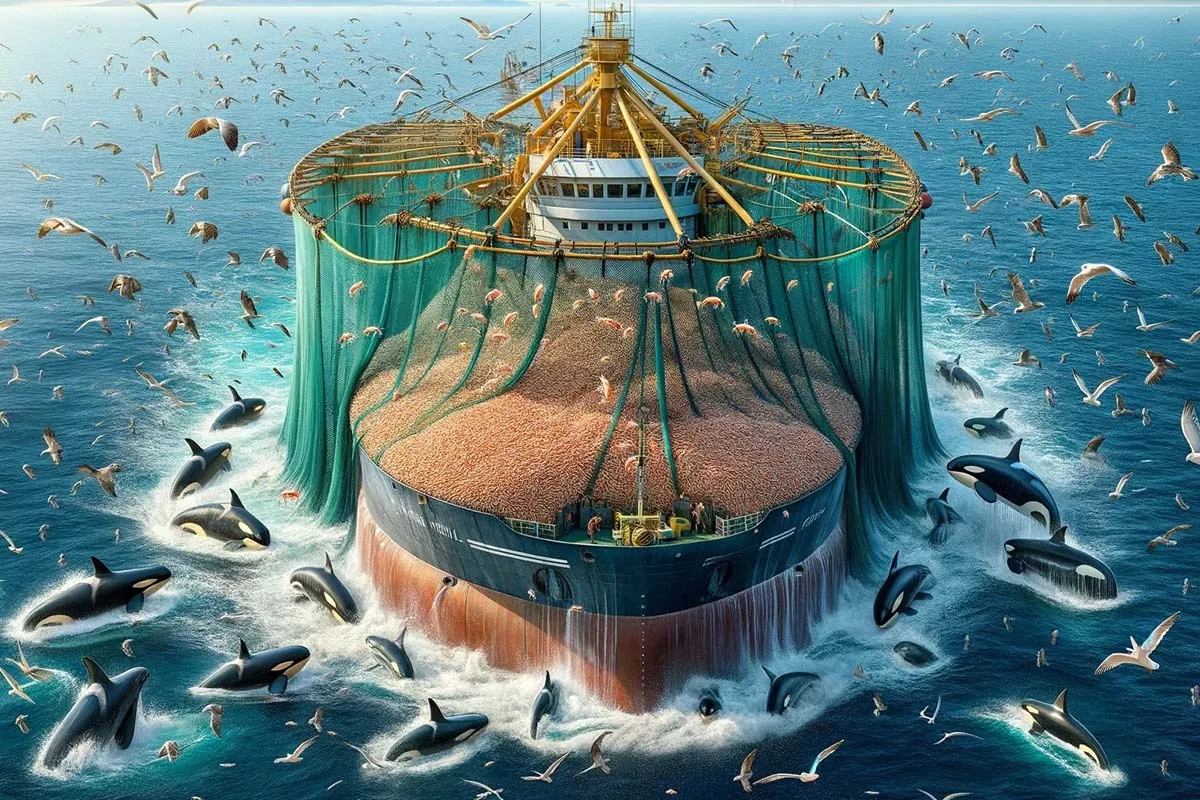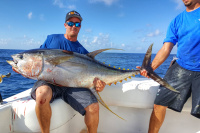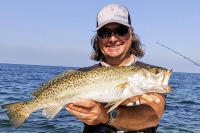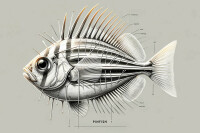Unveiling the perils of krill fishing: a deep dive into how this growing industry threatens ocean ecosystems and disrupts the delicate marine food web.

Krill Fishing: The Hidden Threat to Our Oceans
In the vast, undulating expanse of the world's oceans, where the whispers of eternity echo beneath the ceaseless waves, dwell the krill — diminutive, shrimp-like custodians of the deep. These creatures, often unnoticed and disregarded by the casual observer, serve as the cornerstone of the marine food web, a role as vital as it is unheralded. In their humble existence, the krill, those minute sentinels of the ocean's health, weave the fabric of life beneath the water's surface.
We find ourselves at a juncture, beckoned to peer into the abyss and comprehend the magnitude of these tiny giants upon whose slender shoulders rests the health of the oceans. It is a tale of ecological interdependence, where the fate of the smallest creature mirrors the well-being of the vastest seas. The urgency of the hour calls for a reckoning, a turning of the tide towards sustainable practices that honor the humble krill and preserve the intricate web of life they support.
In The Spread, with its focus on fishery conservation and sustainable fishing practices, provides valuable insights and education for anglers and enthusiasts committed to preserving gamefish for future generations to enjoy.
Meet the Krill
- Across the vast, mysterious expanse of all the world's oceans and seas, in the deep, unfathomable waters, there exist vast congregations of krill, known as blooms. These minute crustaceans, small yet significant, drift in the currents, feeding upon the microscopic phytoplankton. In turn, they themselves are sustenance for the great leviathans of the deep — the whales — and for the denizens of the icy realms, such as penguins, fish, seals, and others in a grand, unending cycle of life and death.
- In this watery world, seven major species of krill ply their silent trade, with the Antarctic krill, Euphausia superba, reigning as the most bountiful among them. These creatures, seldom longer than two inches in their full adult span, traverse the ocean's depths for an ephemeral lifespan of five to six years.
- It was in the era of the 1970s when mankind turned its industrious gaze to these humble beings, harvesting them to provide fishmeal and omega-3 rich oils for the burgeoning demands of aquaculture and animal feed. The wheels of industry churn, and now the krill fishery hauls over 400,000 metric tons annually, a bounty valued over half a billion dollars.
- Beneath this tale of human ingenuity and enterprise, a question lingers, haunting like a specter in the deep — can the stocks of krill endure under the relentless grasp of commercial expansion? There is a growing trepidation, a murmur in the halls of science and conservation, over the ecological consequences that may follow the overharvesting of these tiny yet pivotal players in the ocean's grand opera. The answers are as elusive as the krill themselves, hidden in the depths of our understanding and conscience.

The Role of Krill in Ocean Ecology
In the boundless, churning depths of the world's oceans, where the pulse of life beats in a rhythm as ancient as time itself, the krill, those tiny, seemingly inconsequential creatures, assume a role of monumental significance. They stand as keystone species, pivotal in holding together the intricate tapestry of marine communities, their presence vital to the health and biodiversity of the ecosystems they inhabit. The essence of their importance lies not merely in their existence but in their role as the primary sustenance for a myriad of marine species across various trophic levels.
- Krill as prey: As prey, the krill, swarming in their countless multitudes, offer themselves to the hunger of the ocean's denizens. This abundance of life, a veritable feast, allows numerous marine species to thrive. The leviathans of the deep, the whales, find in krill the cornerstone of their diet, while for some species of penguins, these small beings constitute over half of their sustenance. Seals, fish, squid, and seabirds, too, are inextricably linked to the fate of the krill.
- Nutritional value: Nutritionally, krill are a trove of life-sustaining elements — rich in protein, bountiful in omega-3s, and replete with other essential nutrients. These omega-3s are more than mere sustenance; they are the keystones of brain and heart health for the marine predators that feast upon them.
- Role in carbon cycle: In the grand cycle of carbon, the krill play a role subtle yet profound. By feeding on phytoplankton, they become vessels for carbon, transferring it from the primary producers up through the food web. As predators consume krill, some of this carbon is transported to the depths of the ocean, a process known as the biological pump, aiding in the sequestration of carbon.
- Indicators of climate change: In the shadow of climate change, krill emerge as harbingers of the shifting tides. Their reliance on sea ice to shelter their young and to feed on ice algae renders them vulnerable to the changing climate. The diminishing sea ice spells a dire impact on krill populations, making the monitoring of their stocks a barometer for the effects of climate change.
The Devastating Effects of Krill Overfishing
In the vast, uncharted expanse of the world's oceans, where the whispers of time merge with the ceaseless lull of the waves, there unfolds a tale of human ambition clashing with the delicate balance of nature. Overfishing, a specter born of this ambition, manifests when the creatures of the sea are plucked from their watery realm faster than the rhythms of life and reproduction can replenish them. Amidst this saga, the krill, those small yet pivotal denizens of the deep, find themselves ensnared.
These tiny crustaceans, despite their natural propensity for high mortality, face a peril magnified by human hands. The overharvesting of krill, unchecked and rampant, threatens to rapidly deplete regional stocks, stripping the ocean of its vital threads. This relentless pursuit of krill is marked by a troubling void — a lack of regulation on a global scale. In this void, the absence of catch limits looms large, casting a shadow of alarm over the ecological consequences of exploiting krill populations with such rapacity.


Collapse of Krill Populations
In the vast, cold embrace of the Antarctic, where the stark whiteness melds with the endless blue, there lies a tale of loss and warning. Since the decade of the 1970s, a time not so distant in the annals of history, the populations of Antarctic krill, those small yet vital denizens of the deep, have witnessed a decline — a staggering fall of 80%. This descent into scarcity speaks of a larger, more foreboding narrative, one where human endeavor and the fragility of nature collide.
Amidst this dwindling of krill, scientists find themselves grappling with shadows, for the lack of baseline data shrouds the true impact of the expanding krill fisheries in a veil of uncertainty. This dearth of knowledge, coupled with the relentless pursuit of these tiny creatures, portends a risk grave and imminent — the potential collapse of regional krill populations, a catastrophe echoing the whispers of a not-so-distant past.
The tale turns to the east, to Japan, where in the same era of the 1970s, the krill were nearly swept into the annals of extinction due to excessive fishing pressure. It was a harrowing chapter, a near obliteration, from which the stocks took over a decade to recover, to emerge once again into the realm of abundance.

Starvation of Predator Populations
In the cold, haunting expanse of Antarctica, where the relentless winds carve tales of survival and desolation, there unfolds a story steeped in the inexorable rhythms of nature and the encroaching shadow of human influence. At its heart lies the krill, those minute, unassuming architects of the ocean's food web. Yet, as their numbers wane, a ripple of despair touches the lives of those bound to them by the chains of dependence. The penguins and seals, those iconic sentinels of the Antarctic realm, find themselves ensnared in a struggle for sustenance, a battle against the specter of starvation.
On the shores of the Antarctic Peninsula, a stark testament to this unfolding tragedy is etched in the declining numbers of the Chinstrap and Adelie penguins. Over half of their populations have vanished, shadows of their former abundance, as the stocks of krill dwindle into scarcity. This decrease is more than a number; it is a harbinger of a fraying web of life, where the scarcity of one spells the doom of many.
Amidst the ice and snow, the seals and penguins, driven by the gnawing pangs of hunger, venture further and longer in their forays for food. This relentless quest for nourishment bears a heavy toll, sapping their strength, diminishing their ability to nurture and breed successfully. Each extended journey is a testament to the growing imbalance, a chorus of desperation in the symphony of survival.
Disruption of the Marine Food Web
Juxtaposed against the undulating tapestry of the ocean's depths, where each thread weaves into the next, forming the intricate web of life, the krill — small yet pivotal — hold a place of quiet, unassuming importance. Yet, as their numbers falter and dwindle, the reverberations of their loss echo far and wide, sending ripples through the very fabric of the marine world.
In the wake of depleted krill populations, a subtle yet profound shift begins to take hold. Other zooplankton species, once overshadowed by the abundance of krill, now rise to prominence, altering the balance of life. This ascendancy brings with it a transformation, a change in the very composition of algae species, as the delicate equilibrium of the underwater ecosystem teeters on the brink of alteration.
Above in the sunlit waters, the marine predators — those majestic beings of scale and feather — face a daunting challenge. Bereft of their customary prey, they turn in desperation to alternatives, to sustenance less fitting, less nourishing. This shift in diet, born of necessity, cascades upwards through the food chain. Seabirds and whales, those icons of the ocean's majesty, find themselves feasting increasingly on fish, a choice not of preference, but of survival.
Yet, even this reluctant adaptation is fraught with peril, for the fisheries of the world, driven by human need and greed, have already laid heavy hands upon key fish stocks like mackerel. These waters, once teeming with life, now bear the scars of overexploitation, a testament to the unrelenting demand of mankind.
Ocean Acidification
Spread across the brooding expanse of the ocean, a silent, unseen process unfolds — the journey of the krill, those humble architects of the deep, in shaping the very essence of the sea. The krill, in their unassuming role, craft eponymous fecal pellets, small yet momentous, that descend like whispers into the abyss, bearing with them the weight of carbon, a silent cargo destined for the depths. This process, a biological pump as intricate as it is essential, serves as a guardian of balance, sequestering carbon away from the fragile atmosphere.
Yet, as the numbers of krill wane under the relentless pursuit of human fishing, this delicate process falters. With fewer krill to forge these pellets, the mechanism of carbon sequestration weakens, a subtle yet profound shift in the ocean's ability to cradle the carbon from the world above. This disruption, this breaking of a natural rhythm, threatens to amplify the specter of ocean acidification, a looming shadow cast by the rising tides of atmospheric CO2.
This acidification, insidious and relentless, weaves its way through the marine food web, an unseen adversary. It hinders the very essence of calcification in creatures like the shellfish, those bearers of shells and keepers of the ocean's mysteries. Their struggle, a battle against an invisible foe, echoes the broader peril faced by the intricate network of life beneath the waves.

Achieving Sustainable Krill Fishing
As the world's krill catches swell, climbing ever higher in response to the insatiable demands of a global market, the clarion call for sustainability rings out, urgent and unyielding, in the realm of krill fishery management. Yet, this call begs a question, deep and profound, echoing through the corridors of time and human endeavor: what form shall sustainable krill fishing take? How do we steer the current, unbridled course of krill fisheries towards the harbors of sustainability? In the search for answers, a myriad of recommendations rise like stars in the night sky. Here are some recommendations:
- Set ecosystem based catch limits - First among these is the setting of ecosystem-based catch limits. These limits, not arbitrary but grounded in the wisdom of scientific stock assessments and attuned to the caprices of environmental variability, seek to curb the excesses of overexploitation. They must, in their design, pay homage to the needs of the predators, those larger denizens of the deep whose fates are entwined with the krill.
- Establish marine reserves - Then, there is the call to establish marine reserves, sanctuaries of the sea where krill may find refuge from the relentless pursuit of nets and trawlers. These designated no-take zones not only shelter the krill but serve as bastions of biodiversity, nurturing the resilience of stocks against the tides of overfishing.
- Improve monitoring - In the quest for better stewardship, the improvement of monitoring emerges as a vital step. Expanding observer programs, embracing the new frontiers of technology such as machine learning, would enhance our ability to oversee and ensure compliance with regulations, a watchful eye over the vastness of the oceans.
- Seek certification - Certification programs, like that of the Marine Stewardship Council (MSC), beckon the krill companies towards a voluntary elevation of their environmental performance. This path, marked by the pursuit of certification, offers a beacon for those seeking to marry profit with responsibility.
- Reduce bycatch - The reduction of bycatch stands as another pillar in this edifice of sustainability. Fishing methods and gear must evolve, refine, and transform to minimize the unintended capture of other species — the small fish, the larval crabs — the silent victims of the krill harvest.
- Promote research - Moreover, the promotion of research stands paramount. A deeper understanding of krill population dynamics and ecology is essential in defining sustainable catch levels. This quest for knowledge could be fueled by levies placed upon the very industry that reaps the bounty of the krill.
- Support international action - Finally, the journey towards sustainability is not one to be walked alone. It requires the concert of international action, the harmony of nations and organizations like the Commission for the Conservation of Antarctic Marine Living Resources (CCAMLR). Yet, beyond the realms of diplomacy and international accord, there lies the power of the consumer, the market-driven pressures that can, in their own right, spur positive change.
Conclusion
These tiny creatures, krill, stand as sentinels in the marine realm, occupying a position of crucial importance. They are the keystone species upon which the intricate, labyrinthine food webs of the ocean precariously balance.
This reckless plunder of krill, driven by human hands, sets in motion a cascade of starvation among the predator populations that rely on them. It is a disruption, a dissonance in the symphony of marine ecology, stretching its tendrils to even disturb the great cycles of carbon and the creeping menace of ocean acidification. The specter of this overfishing looms over the seas, a harbinger of imbalance and ecological turmoil.
At the heart of this crisis lies a singular, undeniable truth — the necessity to avert the collapse of krill populations, to enshrine sustainability as the cornerstone of krill fishery management. This endeavor calls for measures comprehensive in scope, a tapestry of policies and practices woven with the threads of foresight and responsibility.
In the realm of possibility, a vision emerges of krill fisheries developed sustainably, where smart policy harmonizes with the cooperation of stakeholders. It is a vision where the economic benefits gleaned from the depths do not come at the cost of the ocean's ecological integrity. Yet, this vision demands more than mere contemplation; it requires urgent, decisive action.
References:
[1] Kawaguchi, S., & Nicol, S. (2018). Krill biology: an overview. In The krill aquaculture perspective (pp. 1-20). Springer, Cham.
[2] Nicol, S., Foster, J., & Kawaguchi, S. (2012). The fishery for Antarctic krill–recent developments. Fish and Fisheries, 13(1), 30-40.[3] Constable, A. J., De La Mare, W. K., Agnew, D. J., Everson, I., & Miller, D. (2000). Managing fisheries to conserve the Antarctic marine ecosystem: practical implementation of the Convention on the Conservation of Antarctic Marine Living Resources (CCAMLR). ICES Journal of Marine Science, 57(3), 778-791.
[4] Trathan, P. N., & Hill, S. L. (2016). The importance of krill predation in the Southern Ocean. In Biology and ecology of Antarctic krill (pp. 321-350). Springer, Cham.
[5] Smetacek, V., & Nicol, S. (2005). Polar ocean ecosystems in a changing world. Nature, 437(7057), 362-368.
Chad Pearler In The Spread, Author
Login
to leave a review.
User Reviews
There are no reviews yet.Complete Dredge Pulley Setup Guide
Saltwater
12.28.2020
High Speed Wahoo Trolling Rig
Saltwater
09.07.2018
Best Bait for Wahoo
Saltwater
12.30.2023
Pinfish - A Comprehensive Guide
Saltwater
11.10.2023
0










